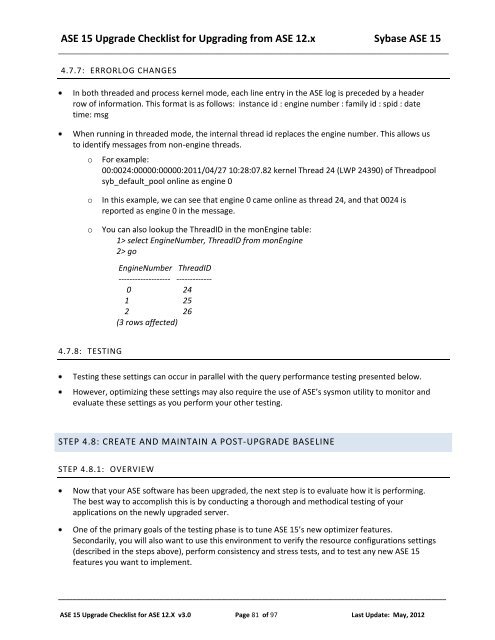Upgrading and Migrating an IQ database from older ... - Sybase
Upgrading and Migrating an IQ database from older ... - Sybase
Upgrading and Migrating an IQ database from older ... - Sybase
You also want an ePaper? Increase the reach of your titles
YUMPU automatically turns print PDFs into web optimized ePapers that Google loves.
ASE 15 Upgrade Checklist for <strong>Upgrading</strong> <strong>from</strong> ASE 12.x <strong>Sybase</strong> ASE 15<br />
_________________________________________________________________________________________________<br />
4.7.7: ERRORLOG CHANGES<br />
In both threaded <strong><strong>an</strong>d</strong> process kernel mode, each line entry in the ASE log is preceded by a header<br />
row of information. This format is as follows: inst<strong>an</strong>ce id : engine number : family id : spid : date<br />
time: msg<br />
When running in threaded mode, the internal thread id replaces the engine number. This allows us<br />
to identify messages <strong>from</strong> non-engine threads.<br />
o<br />
For example:<br />
00:0024:00000:00000:2011/04/27 10:28:07.82 kernel Thread 24 (LWP 24390) of Threadpool<br />
syb_default_pool online as engine 0<br />
o<br />
o<br />
In this example, we c<strong>an</strong> see that engine 0 came online as thread 24, <strong><strong>an</strong>d</strong> that 0024 is<br />
reported as engine 0 in the message.<br />
You c<strong>an</strong> also lookup the ThreadID in the monEngine table:<br />
1> select EngineNumber, ThreadID <strong>from</strong> monEngine<br />
2> go<br />
EngineNumber ThreadID<br />
------------------- -------------<br />
0 24<br />
1 25<br />
2 26<br />
(3 rows affected)<br />
4.7.8: TESTING<br />
Testing these settings c<strong>an</strong> occur in parallel with the query perform<strong>an</strong>ce testing presented below.<br />
However, optimizing these settings may also require the use of ASE’s sysmon utility to monitor <strong><strong>an</strong>d</strong><br />
evaluate these settings as you perform your other testing.<br />
STEP 4.8: CREATE AND MAINTAIN A POST-UPGRADE BASELINE<br />
STEP 4.8.1: OVERVIEW<br />
Now that your ASE software has been upgraded, the next step is to evaluate how it is performing.<br />
The best way to accomplish this is by conducting a thorough <strong><strong>an</strong>d</strong> methodical testing of your<br />
applications on the newly upgraded server.<br />
One of the primary goals of the testing phase is to tune ASE 15’s new optimizer features.<br />
Secondarily, you will also w<strong>an</strong>t to use this environment to verify the resource configurations settings<br />
(described in the steps above), perform consistency <strong><strong>an</strong>d</strong> stress tests, <strong><strong>an</strong>d</strong> to test <strong>an</strong>y new ASE 15<br />
features you w<strong>an</strong>t to implement.<br />
___________________________________________________________________________________________________________<br />
ASE 15 Upgrade Checklist for ASE 12.X v3.0 Page 81 of 97 Last Update: May, 2012




